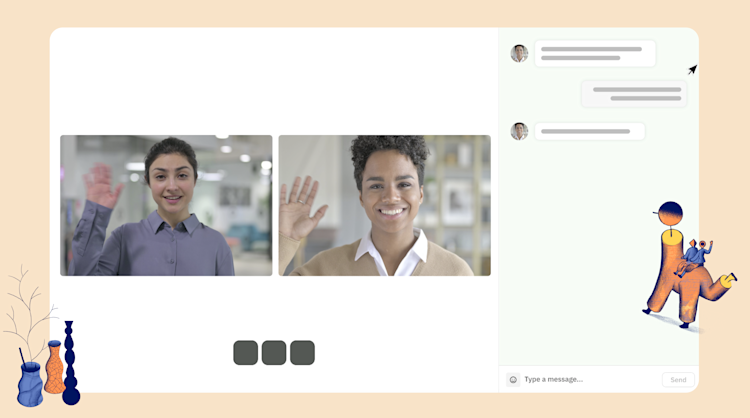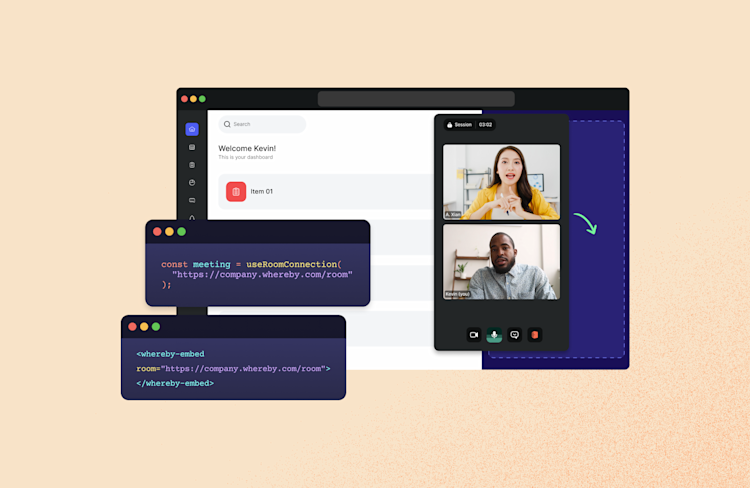Why Embedded Video Is Key to Happier Customers
We hosted a webinar Why Embedded Video Calls are Key to Happier Customers to talk about how video meetings and customer experience are connected, and how you can improve customer experience. Read more to find out more and watch the recording.
We’re living in a digital-first world, and video calls are a major part of that world. For years, the trend toward video has been growing by leaps and bounds. It’s not surprising. Video meetings are a great way to engage with customers, and it’s a proven channel for delivering a superior customer experience that sets a brand apart from the competition.
A year-and-a-half ago, this movement to incorporate more video calls into customer experiences was dramatically accelerated by the Covid-19 pandemic. Almost overnight, interactions of all kinds had to shift into virtual spaces as the world went into lockdown.
Although some parts of life are beginning to return to pre-pandemic norms, many companies have discovered that there are a lot of compelling reasons to continue incorporating video solutions into their customer experience. From onboarding and customer service to meetings and direct services, the use cases in which video can enhance the experience are almost endless.
To help people better understand the possibilities, I hosted a webinar Why Embedded Video Calls are Key to Happier Customers together with Caleb Robertson, our Director of Sales, where we took an in-depth look at how video and customer experience are connected, and how—ultimately—the right video experience can improve customer happiness. Watch the full webinar to get all the in's and out's of embedding video to improve customer experience.

Video can enhance the customer experience, but only if it’s done right.
It wasn’t that long ago that video calls were more of a nice-to-have feature than a must-have component of the customer experience. But as Covid-19 drove shutdowns across the globe, even highly regulated industries (like healthcare and finance) were suddenly forced to embrace digital transformations that included incorporating video meetings.
While many organizations initially implemented video calls as part of a necessary response to the pandemic, they quickly realized its potential to take the customer experience to a whole new level. This realization is a key turning point because in today’s markets it’s all about the customer experience.
A Forrester survey found that “leaders in customer experience” outperformed their slow-to-CX competitors by 80%.
If video calls can help elevate a brand’s customer experience while reducing negative interactions, it can provide a very real competitive advantage.
The problem was that a lot of video solutions couldn’t deliver the right customer experience. Instead of meeting customers where they are, these solutions forced customers to jump through all kinds of hoops. They added friction to the experience, causing customer frustration. And they often took customers off of the brand website or out of the brand application, creating a “broken” experience that was confusing and inefficient.
To make the most of the video opportunity, organizations needed a better video solution—one that was easy to use, delivered a seamless and frictionless experience, and ultimately helped build trust.
Frictionless customer experience
After speaking to our customers, we quickly found the pain points and what our customers needed most. I’ll run you through which industries we see a big uptake of embedding video and how some companies have benefited from it.
Whereby Embedded is the easiest and most reliable way to embed video call technology. It gives companies a huge opportunity to stand out from the crowd by delivering a great customer experience that makes customers happier and more loyal.
Whereby Embedded is suited to handle use cases in any industry:
Healthcare — Connecting doctors and therapists to their patients
E-learning — Connecting students to teachers and tutors
Virtual Events — Connecting attendees with sponsors, organizers, and presenters
Recruiting — Connecting employers and candidates
Marketplaces — Connecting buyers and sellers

These use cases showed that by adding video meetings to their platforms, they saved time and money. It leads to improving access to services, expands the ability to participate, ensures safe and secure connections, and creates a more human experience. But you don’t have to take my word for it. (I am, of course, slightly biased.) Here are some company stories:
NHS and accuRX
This UK health tech company, which provides a text service for general practitioners, was able to implement Whereby Embedded in three days to quickly accommodate a dramatic increase in demand for video consultations in March 2020.

Brella
This Finnish hybrid events and networking platform shifted during the pandemic to become the premiere networking service for online events. Though they tested their video idea with another provider, they quickly switched to Whereby Embedded and have been able to increase engagement and satisfaction with attendees and sponsors alike.

Learnlink
This Norwegian EdTech company started by building their own video conferencing solution, but soon discovered issues as the company scaled. The bugs and stability issues threatened to compromise their reputation and so they switched to a stable, safe and reliable solution for their learning platform, choosing Whereby Embedded. The integrations with tools they were already using (like Miro whiteboards), quick set up time, and having a fully maintained, reliable solution has allowed them to scale and grow rapidly.

If you're interested to know more specifics about our features I recommend watching the webinar to get the details on the specific features that helped these companies and we have some great resources on why embedding video is better for business.
Video calls are the future, and some companies are taking advantage today.
Video is clearly the way of the future, and companies that get out in front of the competition now will have a clear advantage over the long term. The key to both initial and sustained video success is to start smart with a solution that guarantees an experience that will keep your customers happy. You want a video solution that is an asset to your organization, not a liability.


